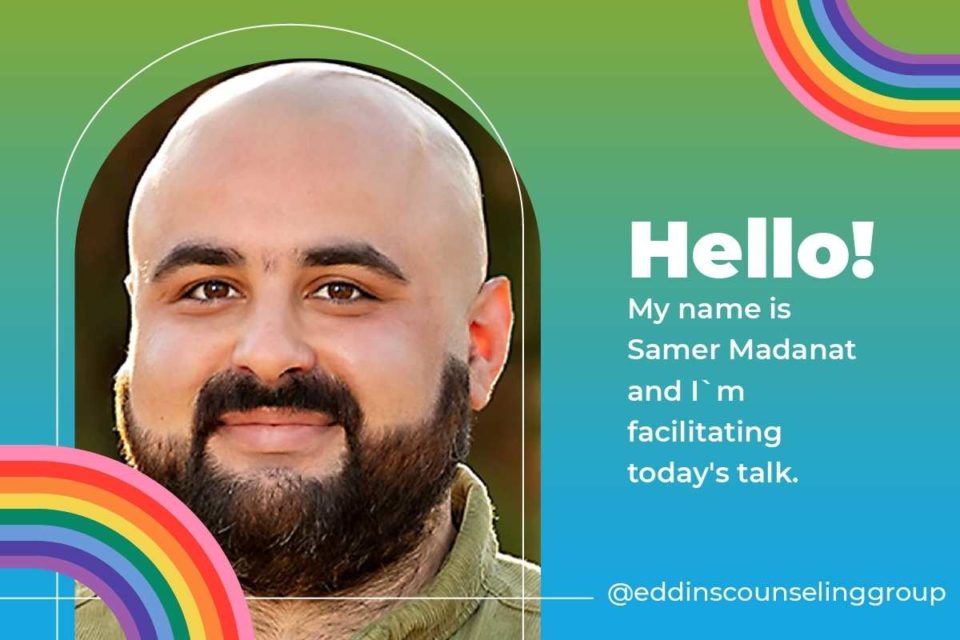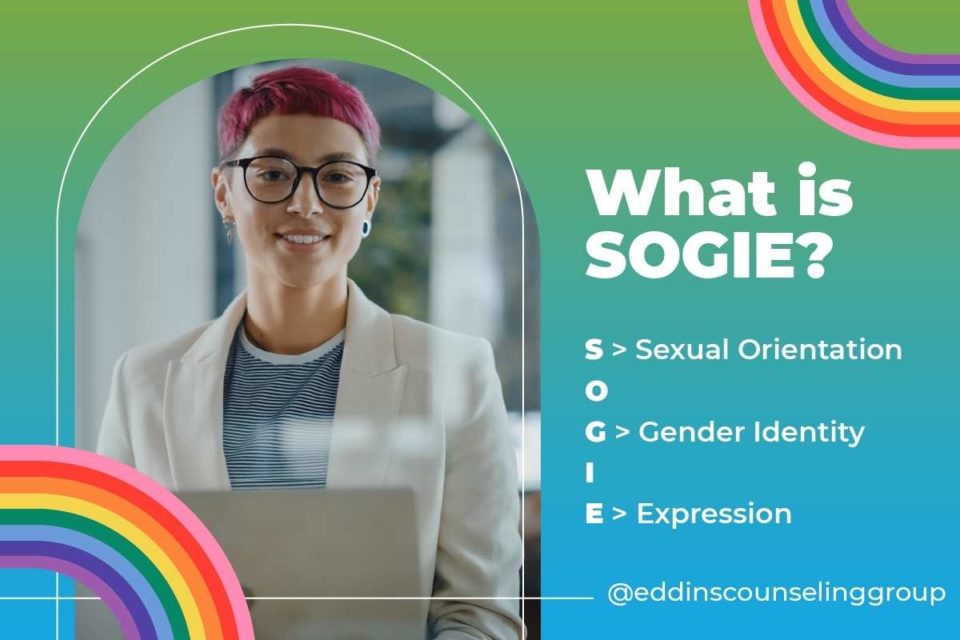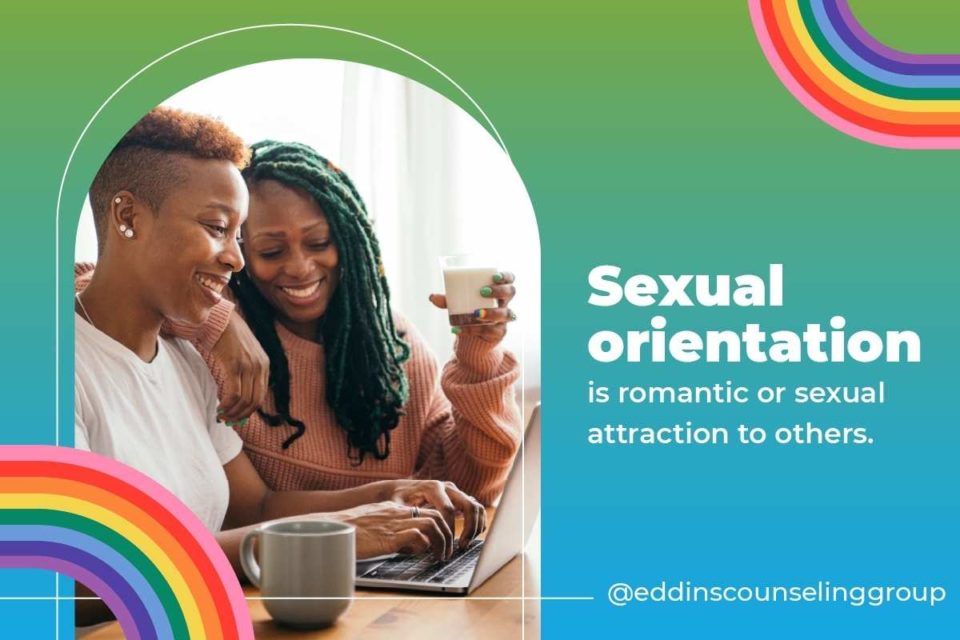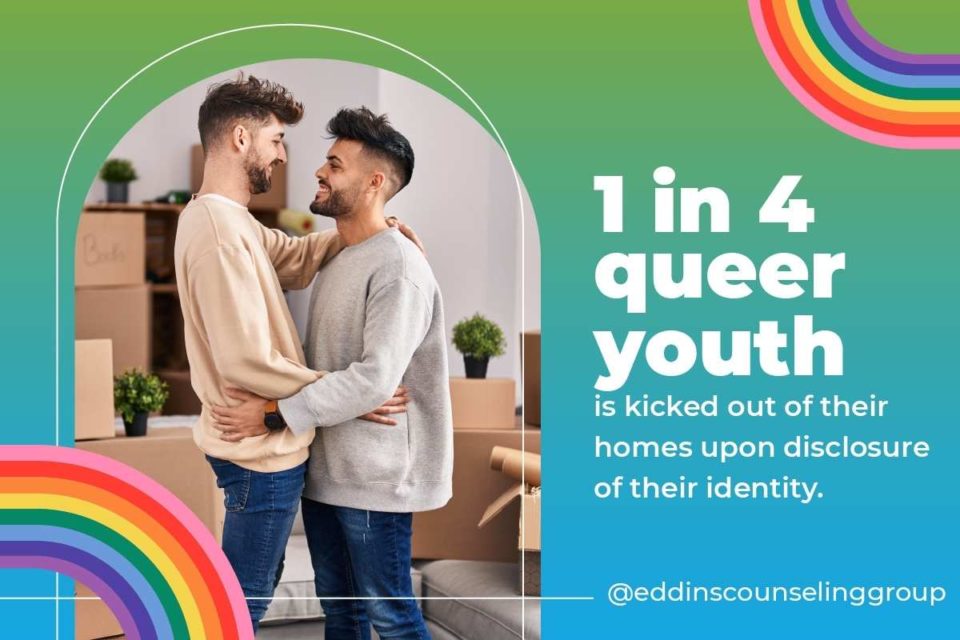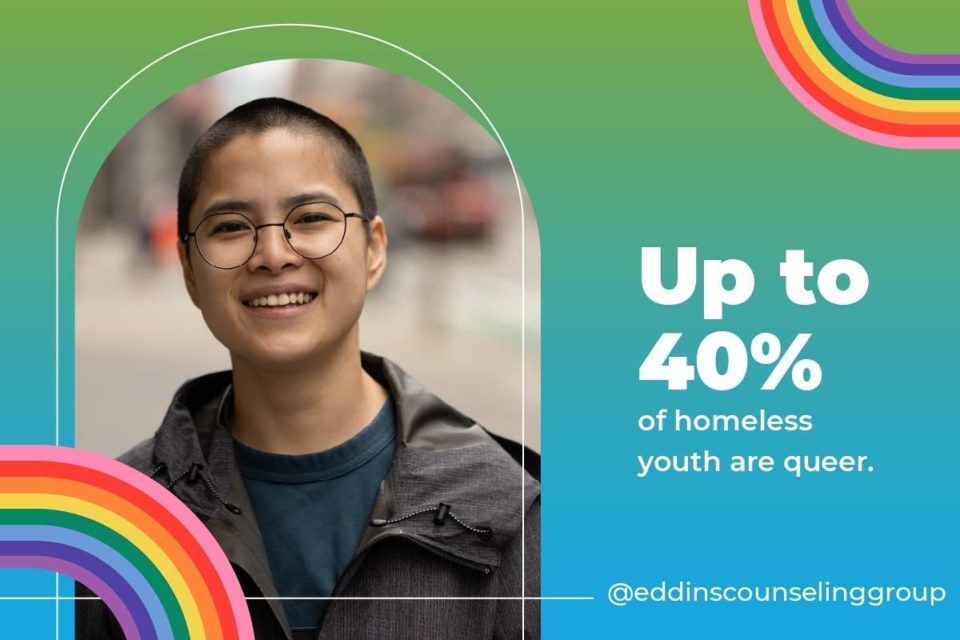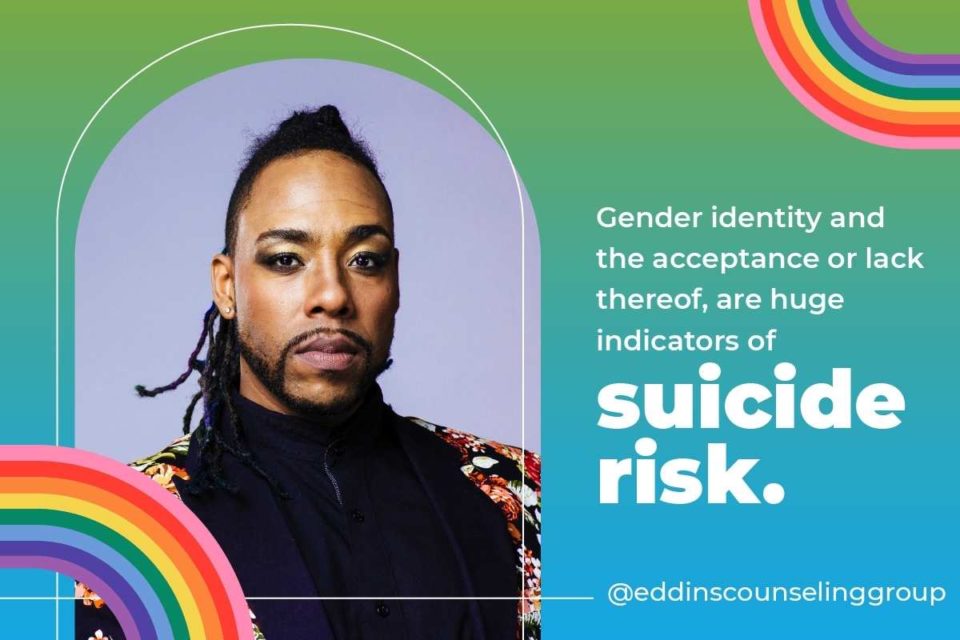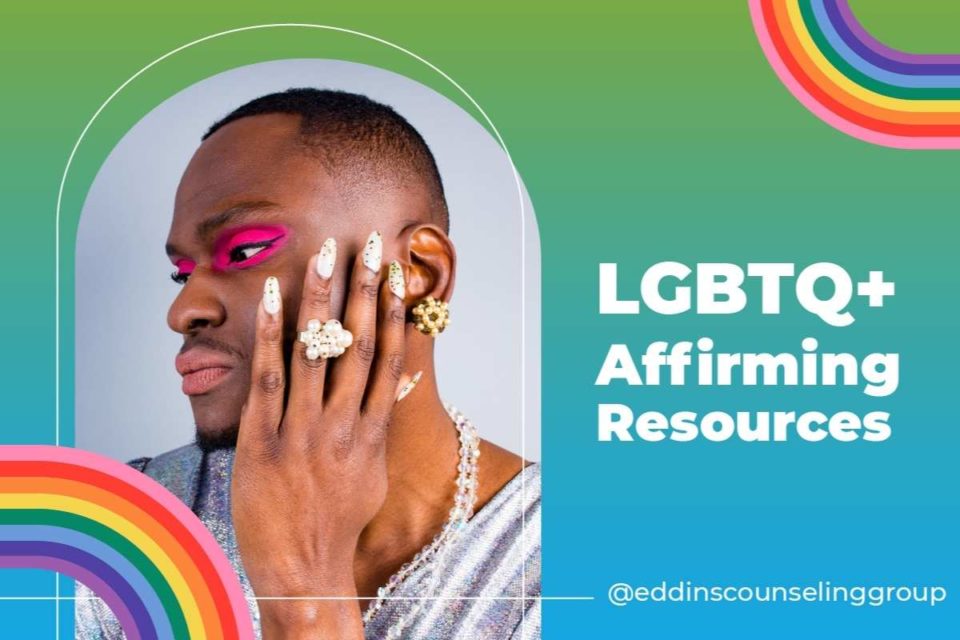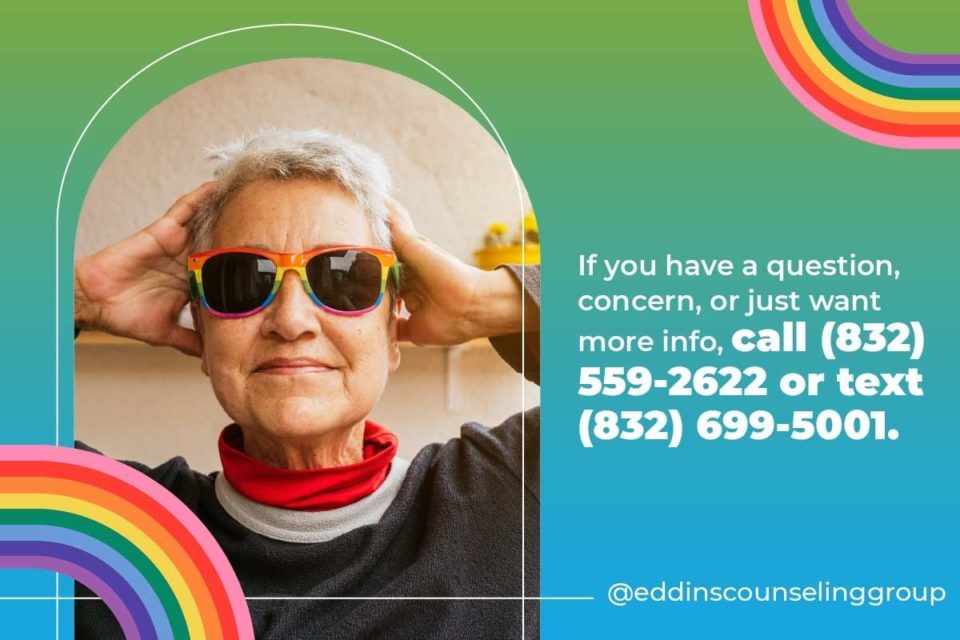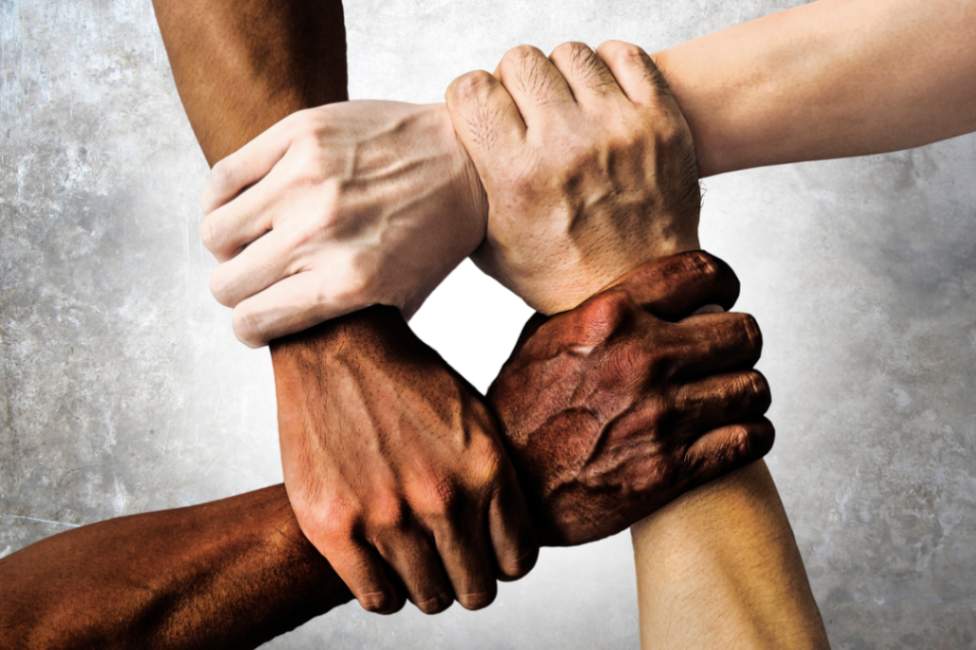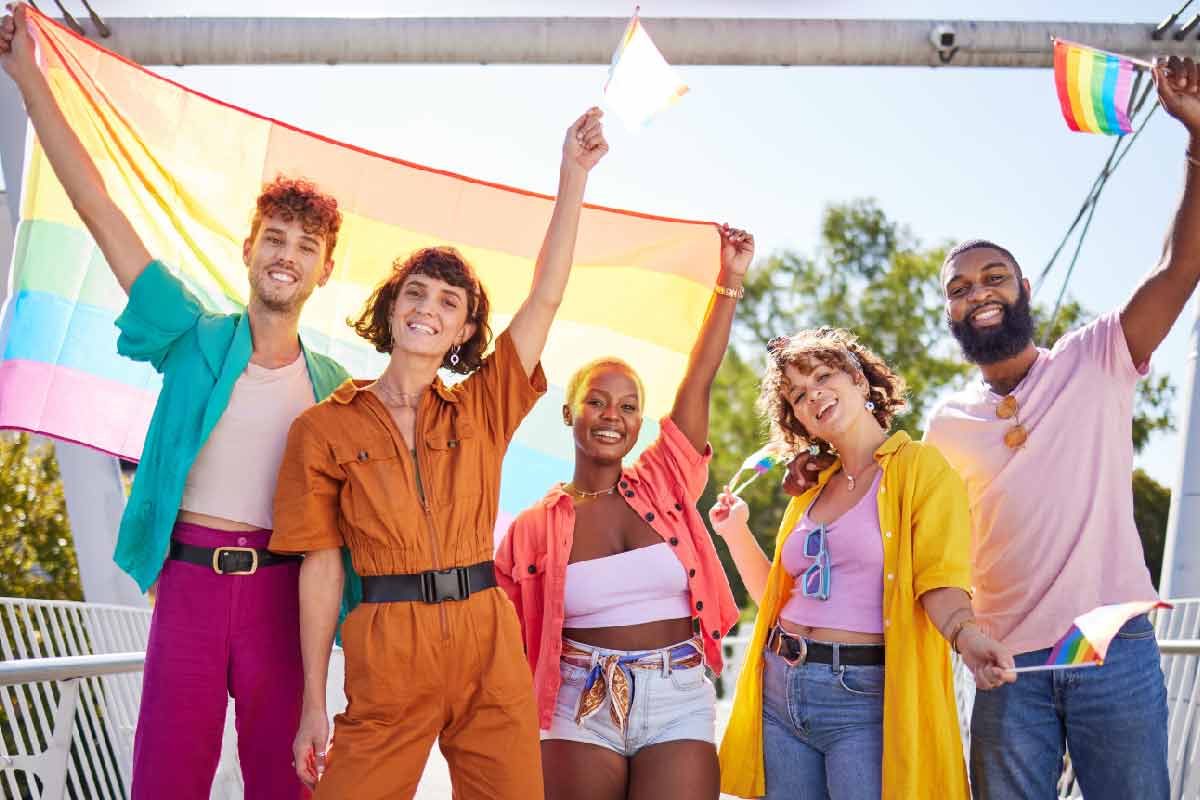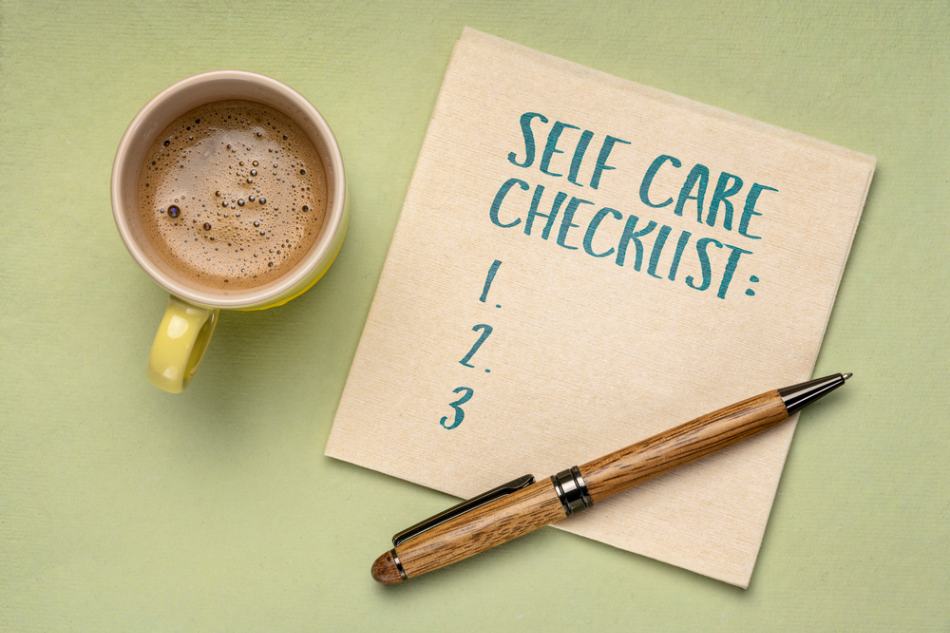June 9, 2022
Webinar: SOGIE 101 (Sexual Orientation, Gender Identity, and Expression)
Written by Rachel Eddins
Posted in LGBTQ + Multicultural Concerns, Webinars and with tags: LGBTQ
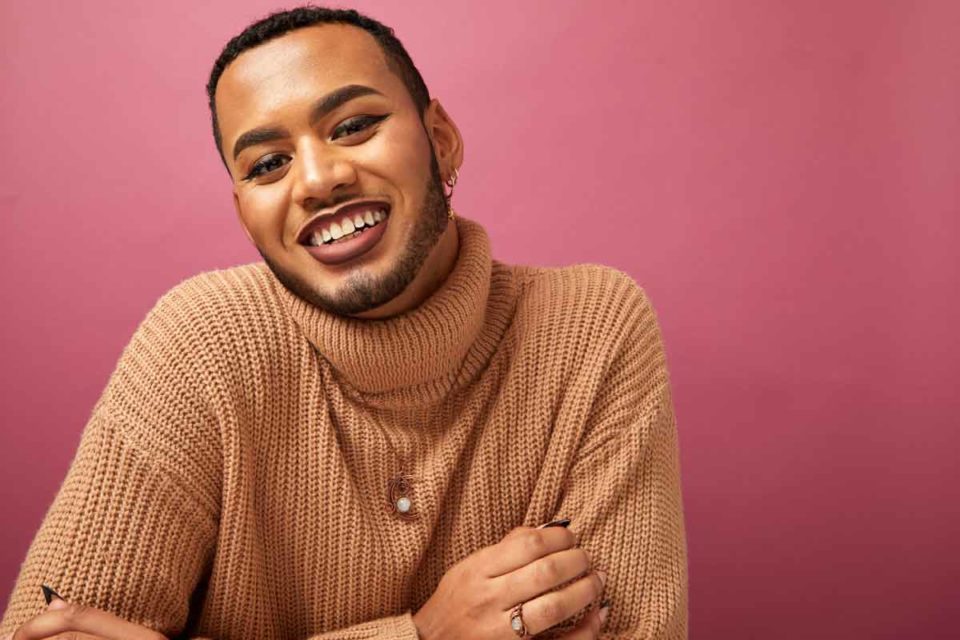
SOGIE is an acronym for sexual orientation, gender identity, and gender expression.
Learn LGBTQ+ history, terminology, and ways you can be an effective ally.
Facilitated by Samer Madanat, LCSW.
Watch a replay of this presentation here.
Learn more about our LGBTQ+ counseling services.
Read the transcript of the webinar here:
Meet Your Therapist
Hello! My name is Samer Madanat, and I’m a licensed clinical social worker. Thank you again for coming to our Focus on Wellness series.
For June, we’re doing SOGIE 101 with the Eddins Counseling Group. I’ve been a licensed clinical social worker in this field for about ten years, and in that time, I’ve really been able to work with all kinds of people from all kinds of backgrounds.
But the community or the work that I’ve found myself most drawn to is working with issues of identity.
As such, I’ve worked with clients of various ethnic backgrounds and the LGBTQ+ community.
A lot of my work is based on individuals, family, and couples work as they seek acceptance, transitioning, and other kinds of topics in this field. It’s something I’m really passionate about.
Q&A Terminology for Gender & Sexuality
Something that has come up a lot in my work is that the topic in and of itself has been really overwhelming, and can even be confusing in terms of language and vocabulary. Moreover, I hear a lot that it is ever evolving. It’s hard to keep up.
My hope today is that we can talk about some of this terminology as it relates to gender and sexuality, kind of go over the 101, so to speak.
First, I want to talk about the history of gender and sexuality, as well as some interesting statistics on mental health that are related. I also want to discuss the language that we can use to be more inclusive, accepting, and understanding of gender and sexual minorities.
So what I will ask you to do throughout the presentation is, if you have any questions about what I’m sharing, take time, in the end, to discuss your questions and these topics together.
If things come up in this conversation that I haven’t addressed that you would like to know more about, let’s talk about it. I’m not going to claim to have the answers to everything, but we can at least talk about it, and maybe I can point you to other resources.
I really do want to preface that there are no silly questions on this topic, and we’re here because we want to understand – there’s a lot we can all learn. I’ve certainly learned a lot from doing this work and this research.
So I really hope that you feel comfortable asking me questions. Let me know how I can help in terms of clarity. I’m happy to do so and hoping that we can have an open, honest dialogue.
SOGIE 101 (Sexual Orientation, Gender Identity & Expression): Terms
What is SOGIE?
SOGIE stands for Sexual Orientation, Gender Identity, and Expression. It’s a little phrase that has been used in research and academic fields. I don’t really hear it anywhere else. So if you want to impress people, maybe hold on to that one.
Sexual Orientation
I’m going to go through some terminology that we hear a lot in these conversations but may not feel comfortable defining ourselves. So I’ll go through those. The first term is sex. Sex is a trait that indicates reproductive function. So essentially, can you host a pregnancy? Do you produce sperm? That’s kind of the underpinnings of that delineation – your reproductive function.
Sexual orientation is romantic or sexual attraction to others, just bearing in mind that there are people who may experience one or the other who is romantically attracted to people but may not be sexually attracted to people.
Gender
The next term is gender – the behavioral, cultural, or psychological traits typically associated with one sex. So basically, what we have assigned as a society, in terms of:
- Mannerisms
- Clothing
- Behaviors
- Ways of speaking
- Ways of engaging with people
All can be informed by our community and our culture. So we have gender norms that can be different depending on where you live.
For example, female autonomy looks different in one part of the world versus another part of the world. They can both feel that they have autonomy. It just looks different depending on the culture and the community that you personally have grown up in.
But gender is essentially the stuff that we assign to the host of the pregnancy or the person who produces sperm.
Gender Identity
Gender identity is a person’s own inherent sense of their gender, so how they identify how they feel: male, female, or otherwise.
Sometimes, it can be incongruent with the sex that was assigned at birth. Gender expression is how we present / how we express that gender identity outwardly. That could be our physical appearance or clothing or accessories.
And like I said, our behaviors, our mannerisms, the way we walk, the way we speak, our societies, our cultures, our communities – explicitly or not – have instilled in us what that looks like.
So what it means to be a woman in Texas versus a man in Saudi Arabia are all very different and relative. But gender expression is how we choose to express who we are on the outside.
Gender Dysphoria
Another term I’d like to point out is gender dysphoria. And that’s discomfort or distress related to the incongruence between a person’s gender identity and their sex assigned at birth.
Someone who is assigned male at birth but identifies as a trans woman or identifies as a woman may experience gender dysphoria during puberty. As they’re growing facial hair or they don’t have breast tissue, their female peers who are experiencing things of that nature can contribute to gender dysphoria.
They’re saying, “ I’m struggling mentally and emotionally because I’m not representing who I am on the inside.”
On the outside, there’s incongruence. A term that I hear a lot, I’m sure some of us do is “Cisgender” or “CIS”.
What that word basically means is that someone identifies with the sex assigned at birth. So a CIS gender woman who was assigned female at birth identifies herself as a woman.
So the opposite, transgender, is any person who does not identify with the sex assigned at birth. This could be someone who is assigned male at birth but identifies as a woman or somebody who identifies as non-binary (neither male nor female or both).
Simply put, CIS versus trans is:
- CIS. I am born a female // I identify as a female trans.
- I was assigned female at birth // I do not identify as female.
Nonbinary
Nonbinary is an umbrella term to describe any gender identity that does not fit into the binary of male or female. Non-binary is an identity in itself, but it’s also sort of an umbrella term.
We’ve heard all kinds of gender identities, and I imagine sometimes we hear one that we’re not quite sure what that is, or they sound similar. There are so many languages and identities, and words to describe shared experiences.
I also can see the challenge in that. So a non-binary person can look like a lot of different things. One person who rejects the binary may identify as androgynous or agender – neither male nor female.
There are also non-binary people who sort of conceptualize gender as a spectrum and may identify as, for example, by gender identifies, male or female, male and female, really just kind of depending on how they’re feeling / what’s going on. They’re non-binary in a different way.
I know that may be kind of convoluted and confusing, but hopefully, that’s kind of given some insight into what the term non-binary means because I think that’s becoming more prevalent in our culture today.
Queer
Another umbrella term that I may use sometimes interchangeably with LGBTQ+ is another umbrella term: queer. Queer is essentially anyone who does not identify as cisgender or heterosexual. So queer can be a term that encapsulates somebody’s gender identity and/or sexuality.
So I may say “the queer community” instead of “LGBTQ”. Plus, I do want to note that the word “queer” historically has had a negative connotation. It has typically been a slur. And I think that’s more common.
To the experience of queer Gen Xers and queer Baby Boomers, this was a slur. This was derogatory.
Younger generations have reappropriated the term queer as not only for the empowering but as a label and an identity.
However, I think it’s important to be mindful of that: that there are people in this world who find the word “queer” deeply offensive and triggering and navigating. That sensitivity is really important.
One concept that gender and sexuality are on a spectrum means some may believe that no one is exclusively heterosexual or homosexual.
And some people identify as such.
They may be straight and have experienced certain sex attractions or vice versa. Oftentimes I’ll do this exercise in a group and adolescents will plot where they are or even create their own, imagining “What would I look like if I was my most authentic self.” They have that regarding identity, expression, sexual attraction, and romantic attraction.
Cultural History of SOGIE
India
Something that I hear a lot in this work is that this feels new. This doesn’t feel like a real thing. People, queer people, trans people, this feels like something that hasn’t really been happening in society, and now it’s just here all of a sudden all at once.
And I want to assure you that there have been people who are clear or gender creative. For example, the Hijra identity in Hindu society has existed for over 2000 years. These are people who are not male or female. Some are intersex, meaning that they may have primary and secondary sex characteristics (reproductive characteristics of both sexes).
So that can just look different for everyone.
The Hijra identity was not male, not female. They were revered in society as connected, religious beings. Essentially from what I’ve gathered in my reading, they were seen and perceived by their peers as the most integrated beings because they have this balance of masculinity and femininity that they were able to master and hone.
There was even a belief that this sort of led them to be enlightened people. These were people who conducted religious rituals and events such as when a child was born or weddings. I think that’s something that I will discuss later as well as this connection to prosperity and love and these people.
Currently, this is a statistic from 2014 there are about 3 million people who identify as Hijra in India, and the climate has changed. They are not as revered and as accepted as they once were. Something we’ll see again shortly.
Native Americans
I do want to acknowledge that in the U.S., Native American people have typically identified as two spirits similar to Hijra. The difference is that they could identify as male or female as well as intersex. But they combined the activities of both.
Similar to South Asia, they were healers, shamans, and ceremonial leaders. In some tribes, they were sort of like social services. They would take in elderly people, widows, sick children, and orphans – and take care of them.
They were deeply reviewed and they have a very functional role in their societies. They were also believed to be lucky. Villagers believed that they could bestow this luck upon others, so they were often a part of wedding celebrations and things like that.
Trans & Nonbinary has Existed Historically
Trans and nonbinary experiences, while it looks different than what it is today, have historically happened and existed without judgment and actually with celebration.
In terms of prevalence today, the Pew Center Research describes that 1 in 6 Gen Z adults (anyone born between 1997 and 2000) identify as members of the LGBTQ plus community.
I think that speaks to that sort of understanding that maybe younger generations are experiencing their sexuality or expressing their sexuality on a continuum, if we’re looking at trends regarding sexual orientation.
With these kinds of stats we can take this with a grain of salt to some extent. I think generally there’s under-reporting so people may not be comfortable sharing their identity, so it could be higher even for the other generations.
But we’re seeing this jump in terms of people who are openly proclaiming their identities as gender and sexual minorities in this generation.
SOGIE & Wellness
Wellness Statistics
I want to talk about the impact of acceptance on one’s physical health, and we’re also going to talk about mental health.
This information is targeted toward adolescents, though I do have some information regarding adults as well.
1 in 4 queer youth is kicked out of their homes upon disclosure of their identity.
In fact, up to 40% of homeless youth are queer, and that’s actually been pretty consistent over the last ten years. Queer high school students and young adults are significantly more likely to report recent cannabis and alcohol use than their straight peers.
So we’re seeing increased substance use, and increased homelessness, just simply for them being in this category.
Suicide Prevention Hotlines and Lifelines
-
The Trevor Project: (866) 488-7386
-
National Suicide Prevention Lifeline: (800) 273-8255 (online chat available)
-
The Gay, Lesbian, Bisexual and Transgender National Hotline: (888) 843-4564
-
The GLBT National Youth Talkline (youth serving youth through age 25): (800) 246-7743
-
Trans Lifeline: (877) 565-8860
Mental Health Stats – Increased Risk for Suicidality
In terms of mental health and suicidality, trans youth are three times more likely than their cisgender counterparts to experience depression. Non-trans queer youth are more than twice as likely to feel suicidal, and over 4 times as likely to attempt suicide compared to their heterosexual counterparts.
Youth with the least accepting families were more than 3 times as likely to consider and attempt suicide.
And particularly with trans youth, 1 in 3 have seriously considered suicide, and 1 in 5 have actually attempted.
Unfortunately, gender identity and the acceptance or lack thereof, are huge indicators of suicide risk.
For teens and young adults, it’s really important to if we’re working with or knowing someone who is trans and struggling to sort of understand that there is a risk involved with not being accepted or not feeling social support in regard to their identities.
Regarding adults, non-trans / queer adults are twice as likely to have a mental health diagnosis than their heterosexual counterparts. The rate quadruples for transgender adults. So transgender adults in the U.S. are 4 times as likely to have a mental health diagnosis than cisgender people.
Similar to trans youth, non-trans / queer adults abuse substances at double the rate of their straight counterparts, and that rate quadruples for trans adults. So again, we’re just seeing that trend of more substance use, more mental health diagnoses, and more suicidality.
According to research, 40% of transgender adults have attempted suicide. In comparison to 5% of the general U.S. population. That’s something that really sticks out to me. That’s eight times the rate of the general U.S. population.
So it’s very likely that trans people if they have not attempted suicide, have really thought about it to some extent.
In their life and their journey, non-trans queer adults are twice as likely to attempt suicide than their heterosexual counterparts. So 10% may not feel like a lot, but when there’s a discrepancy with other communities, it just shows that there’s something going on.
How to Respond to Someone Coming Out to You
So the next part of this presentation, I’m going to sort of reference things that I’ve heard in my work with family counseling, couples counseling, and individual counseling, particularly related to identity.
How do you know?
It’s something that I’ve heard a lot of clients share.
I think a question I pose is: when did you know you’re straight? Nobody really thinks about that. It feels like a flippant question.
It’s not necessarily what I mean. It’s just sort of to exemplify that straight people have been absolved of that sort of expectation.
It also implies that someone actively chose to not be straight.
So I think just generally that would be a good question to just avoid.
Coming Out Doesn’t Mean Someone is Confused, or Just “Finding Out”
I think something else that comes up is that by the time somebody shares this information, I think it’s common to assume that this is a brand new thing. I always tell parents, don’t assume that this is a new thing for your child just because they’re talking to you about it.
Now they could have been stewing on this for years and months or talking to other people about it and working to tell you that.
So don’t assume that they’re confused or unsure. I think just keep questions open and curious. And I think instead of asking this question, saying, “Thank you for feeling comfortable to share this with me.” “Would you like to talk about this?” Or “I’m here for you if you want to talk about this more and unpack this together.” would be a more appropriate response.
Something else that I’ve heard, especially working with adolescents, that this is just a phase is pretty much up there, like, you’re going to grow out of this. I think that’s dangerous because it kind of shuts down someone’s ability to feel curious about their sexuality and their gender. It could very well be a phase in this journey of understanding your own identity and experiences that may change something.
An example that might be helpful is there’s a common experience, perhaps particularly with men, of men coming out as bisexual and ultimately identifying as gay.
And that’s absolutely not to say that every man who is bi is gay.
In my work, things that I have seen are claiming that bi is a way to tether me to the possibility of being straight, the possibility of continuing to be accepted while allowing myself to explore this part of my sexual identity.
Maybe they’ve been with women, but now they feel attracted to men as well. And they’re claiming that and some people may find that in that journey they are not attracted to women as much or at all. So that’s just an example.
And just because they’re no longer whatever identity they claim to be, it doesn’t negate who they are and what they’re going through. It doesn’t make this fake or a fad.
We can all relate to that journey of self-discovery in adolescence:
- Finding out who you are
- Your values
- What you like
- Your labels
- Your identities
- Communities that you feel connected to
It’s not entirely different for queer youth.
Please don’t tell anyone else.
I hear that quite a bit more. So in the context of a parent to a child, that’s not helpful. I think instead of asking that question, what could be helpful is kind of moving forward.
“How would you like your life to be different?” If someone is coming out as trans or gay or lesbian or otherwise…what now?
What next?
Maybe understanding what they see for themselves … that might be coming out to school or coming out to this person or changing their gender expression.
Asking not to tell anyone else, I think, comes from a place of protection, like wanting the person to feel protected, but we can talk about that in a different way that doesn’t feel shaming.
And so just saying, “Okay, what’s next?” “How can I support you?” Or “What do you see for yourself?” I think would be a more appropriate way to address that.
I’ve known all along.
Now this one I will admit we kind of poke fun at. I believe that it comes from a place that can come from a place of kindness and acceptance.
I think that even happened to me when I disclosed it to a friend and I was like, what’s that supposed to mean?
It can sort of rely on that trope of like, there are certain ways you appear gay or queer. If you do this certain behavior, you are that, and it’s just very reductive and stereotyping. So I think that’s just a statement to avoid.
Even if you did, even if I kind of joke and call it a glass closet, it’s not a helpful thing to say. It could easily become a shame response.
Instead, express your gratitude and trust.
So again, I think practicing gratitude, like, “thank you for trusting me.” “Thank you for feeling safe with me.” “Thank you for allowing me.”
It’s not about necessarily coming out. It is sharing who I am with you. I’m so comfortable with you. I trust you so much, I’m going to allow you to access this part. Seeing that as a privilege, and can be very empowering to someone who may be struggling with the self-disclosure process.
I love you anyway.
“I love you anyway” is something that I hear a lot. And surprisingly or not, it has actually caused a lot of pain to trans people specifically. I think it implies, ‘I love you in spite of…. I love you despite…. I love you, even though…’ and it’s sort of inadvertently choosing to overlook that, to be in relationship with you, which may not be the case.
And if that’s not the case, we don’t want people to feel like I love you in spite of this defect because it’s not the case.
Some more language to avoid
What are your preferred pronouns?
I think really the problem is the word “preferred”. Preferred implies that one has a choice to use your correct pronouns or not. It’s not a preference of who you are. If you’re a woman, you don’t prefer to use she pronouns, you use she pronouns.
At the beginning of the presentation, or typically when I meet people, I think the way to navigate pronouns and it’s obviously something I can get into the habit of, is saying, ‘Hi. My name is so and so, I use X pronouns.’
You can ask someone, ‘Are you comfortable sharing your pronouns with me?’
Introducing yourself with your pronouns is a way to create that space without explicitly asking someone. So people may feel less on the spot when you say, ‘Hi, my name is Samer, I use these pronouns.’ And you may invite that response. ‘I’m so and so, I use these pronouns.’
But if you want to ask, I think the best thing to do is to say ‘What are your pronouns, if you don’t mind me asking?’
What is deadnaming?
Deadnaming is using the name of a transgender person before they change their name, and when they were not living in congruence with their expressed gender identity. I think this can be particularly triggering to people who have transitioned and it’s really something to avoid.
Obviously we make mistakes. I think I’ve seen this in relationships. I knew this person, my child, or my partner – we were together before they transitioned. And having a new name, that can be really tough in the beginning to sort of get adjusted too.
So it’s not the end of the world. You’re not a terrible person if you make mistakes.
I think being intentional about working on it is really key and correcting yourself. So if you deadname someone, you immediately say the correct name, you apologize.
And you move forward in the conversation.
If they want to process it, that’s totally fair. But just being mindful of it, that it takes time and patience and effort.
Avoid Male to female / Female to male.
He used to be a boy / she used to be a girl.
Until recently, it was pretty widely accepted. I think now we have more kind of an unbalanced understanding of why these terms might not be the best.
That terminology in and of itself really reinforces the idea how trans people have categorized it or reflected their inner experience
I said “gender and sexual minorities” in the beginning. I think that can also, from a strength based perspective, not be the best terminology to use. I’ll call myself out. You can say ‘gender and sexually diverse communities’.
People have terms that have worked for them or they’ve heard or they’re curious about. You can let me know in the comments. But avoiding sort of the ______ to ______’ I think would be best.
Avoid bringing up medical intervention.
Another thing I would avoid, or I would caution you to avoid, is bringing up surgery and medical intervention when someone discloses their “transness” to you. Not everyone who is trans wants to medically transition.
And when I say medically transition, I mean doing hormone replacement therapy or testosterone blockers. That would also be a part of hormone replacement therapy or top surgery, bottom surgery, facial feminization, electrolysis, stuff like that.
Again, not everyone who is trans wants to medically transition. So I wouldn’t really bring it up. Unless someone brings it up, if they want to process it, if they are thinking about it.
Just any way you can be supportive: ‘Let me know how I can help you.’ Whatever that may look like, maybe going to appointments or helping them with post off. I think it’s obviously something that you might be curious about, especially if it’s a loved one.
What does this mean for you moving forward?
What is life going to look like for you?
So this is a valid question or concern, but maybe allow that person to take the lead on that. Because again, we don’t want to reinforce ideas like you have to medically transition to be trans.
LGBTQ+ Affirming Resources
I do want to share some resources that have been really helpful and then we’ll have some time for questions and discussion, general discussion.
So Southern Equality is really cool. It is a website that’s a guide for local affirming service providers.
They have practitioners in Houston and all over the state. So if you ever have a friend or you yourself are interested in working with someone who is affirming to gender and sexually creative communities, I would encourage you to check out Southern Equality or have them check out Southern Equality
PFLAG Houston is another organization. I’ve actually attended a PFLAG meeting (that’s Parents and Families of Lesbians and Gays). Not the most inclusive name, but I think they do great work. They have meetings, sort of general community meetings. I’ve seen queer people bring family members. They have educational resources and educational events. They have all kinds of stuff going on. I believe they still meet in Midtown. They used to meet at this Methodist Church across the street from the Fine Arts Museum, but that was several years ago. So I would go to their website to kind of get the most updated information on what they’re doing.
The National Center for Transgender Equality is a fabulous resource. I’ve gotten so much statistical information, research, just a wealth of knowledge about sort of the health outcomes, all these things that we’ve discussed today. And also they’re great if you’re trying to find a local organization to support or get services. They have that information as well, similarly, as does the Trevor Project.
So you’re trying to just gain more general knowledge of this topic or find local providers or just local organizations. These are great resources to access. I completely encourage you to do that. If you have any questions about these things, you can totally reach out, let me know.
Part II: SOGIE Q & A
Now we’re going to go ahead and review your questions. I’ll read them aloud, and we’ll discuss them together.
Chris said, “I definitely prefer the phrase ‘gender and sexually diverse communities’.
Yeah, I think it’s about a strength-based perspective. Minorities, it implies a sort of a lack of power, a lack of privilege, lack of access. And all that may be true. It’s not necessarily how we want to frame the community. So that’s something I need to work on.
What is the best way to find gender-affirming therapists?
Great question. Thank you, Brittany. What I have found helpful, what I’ve directed even people in my personal life to do:
Psychology Today is a great website that has you can search for therapists by zip code.
What I appreciate about Psychology Today is that they have search filters. So you can filter your insurance, you can filter the topics you’re going to want to address in therapy, the types of therapy, the interventions that you are interested in (like DBT, CBT, stuff like that).
One other piece of that is LGBTQ+. So you’re able to click on it and find providers who have disclosed that. They work with this community. But further than that, something I would recommend is let’s say you do that: you find a therapist. Most therapists, you can schedule a consultation, and I think it’s important to talk about that.
So contact someone you’re interested in and say, “Tell me about your experience with this population. Do you see people like me? Have you worked with issues that I’m navigating?” and just be really open and honest.
There’s nothing wrong with having a conversation like that and saying, maybe they’re not the person for me. You’re taking time out of your day in your life to do this work.
It’s really important that you find someone that is a good fit.
I think what I hear often is it’s hard to process things and also educate your therapist. And to some extent, it’s not necessarily your job to educate your therapist. Obviously, in getting to know you, they will learn things. But therapists also have the obligation to educate themselves and to be advocates for social justice. So I think for any therapist, it would behoove them to truly explore that.
And I think it’s okay to ask questions. It’s okay to ask them about their experience.
So Psychology Today & Southern Equality have a provider list, and I imagine the Trevor Project and the other organizations I’ve listed will have community health clinics maybe that have individual therapists, family therapists, and couple therapists.
You can even contact local LGBTQ+ organizations in your city and say, ‘Hi, do you provide mental health services?’ And then go from there.
So there are quite a few different options. But if anyone else knows of other resources to locate queer therapists, please feel free to share that.
But again, these websites are great resources. I think going to any organization that has care support groups can also be really helpful. I know locally the Montrose Center has a coming-out support group. They have a trans fabulous support group. So finding communities, I think, can also be really helpful.
Chris asked, who can claim queer identity? I have encountered cisgender and heterosexual people who identify as queer. Do you have any insights?
That’s a great question, Chris. Thank you for asking that. It’s like when we get bogged into it. This is, I think when it can feel really convoluted and confusing.
Regarding this experience, that’s totally valid.
I hearken back to sexuality as a spectrum. For example, there could be people who identify as gay. But they have had sexual experiences with women, for example, or they generally are with men, but have had romantic attraction to women in romantic relationships.
So they may generally appear CIS / hetero. If we’re really conceptualizing their identity on a spectrum, then they may claim queerness.
What if a client does not want to be homosexual or transgender and they are interested in conversion treatment? Is it ethical to refer them to a program like that?
I’m a licensed clinical social worker. So in my code of ethics, I am obligated to be an advocate. And I believe the NASW has condemned conversion therapy.
I would probably tell someone that my ethics, my values as a professional, and my goals, are not compatible, and unfortunately, I cannot refer you to those services.
You can say it’s not ethical, but I think that’s challenging because we’re obviously navigating someone who’s really struggling with where they’re at and say, you know, try to create as minimal harm as possible. And meeting someone where they’re at, just keep it at ‘I don’t think we’re a good match. And I cannot refer you to the services. I’m just not aware of them.’
I don’t know if it’s the best response, but I feel like it’s the most practical, the most realistic, because the last thing I would want to do as a clinician is put someone in a traumatic situation. Do no harm.
Thank you!
Next Steps
You can check out the Eddins Counseling Group to schedule a session with a gender-affirming and LGBTQ-friendly therapist.
We offer both LGBTQ+ individual and couples therapy.
If there are specific topics that you want to work on or specific therapeutic modalities, we have therapists that are using those, so you’ll be able to find your fit.
I’m so open to this conversation because it’s a passion of mine to talk about gender, and sexuality with people and to raise support and understanding. So if you ever have a question, thought, concern, or just want more info & resources, just give us a call. We’re happy to have those conversations.
To get started with an Eddins Counseling Group therapist in Houston, Montrose, or Sugar Land, call (832) 559-2622 or text (832) 699-5001 us today!
Additional LGBTQ+ Resources
- Webinar: Coming Out as a Process
- Webinar: PRIDE – Providing Resources, Information, Demystification, and Education to Be a Supportive LGBTQ+ Ally
- Webinar: SOGIE 101 (Sexual Orientation, Gender Identity, and Expression)
- Overcoming the Mental Health Challenges That Face The LGBTQIA Community
- Why Finding an LGBTQ+ Friendly Therapist is Important
- Benefits of LGBTQ+ Relationship Counseling in Texas
- Benefits of LGBTQ+ Counseling and Exploring Sexual Orientation Through Therapy
- Caring For Yourself While Living in a Non-Affirming Environment
- Eight Ways to Explore Your Pride During Pride Month
- LGBTQ Pride: Meanings, Definitions and Being an Ally
7 Mood-Boosting Tips
Get instant access to your free ebook.

